HIV Cases In Philippines Surge by 500%: Health authorities in the Philippines are raising urgent alarms over a dramatic spike in HIV infections, warning that the country could soon face a full-blown public health emergency. The Department of Health (DOH) has revealed deeply concerning figures, showing that new HIV cases have surged by 500% compared to the same period last year.
HIV Cases In Philippines Surge by 500%
Health authorities in the Philippines are raising urgent alarms over a dramatic spike in HIV infections, warning that the country could soon face a full-blown public health emergency. The Department of Health (DOH) has revealed deeply concerning figures, showing that new HIV cases have surged by 50% compared to the same period last year.
Currently, the country is recording an average of 57 new HIV cases every single day, a rate that experts say could push the country’s healthcare system into crisis mode. The vast majority of these cases—95%—are men, and young Filipinos are the most affected group. Data shows that 33% of new infections are among individuals aged 15 to 24, while another 47% are aged between 25 and 34.
Another major concern is that only half of all individuals living with HIV in the Philippines have been officially diagnosed. Of those diagnosed, just 66% are receiving anti-retroviral therapy, a critical treatment that suppresses the virus and prevents progression to AIDS.
The primary driver of transmission remains sexual contact, particularly among men. This pattern is in line with broader global trends, but the rate of increase in the Philippines is notably higher than in many other countries.
On Tuesday, the DOH made an impassioned plea for nationwide action, stating that it may be necessary to declare a public health emergency to trigger more aggressive and coordinated efforts. Under Philippine law, such a declaration can be made by the president if an epidemic threatens national security. The last time this power was used was at the onset of the COVID-19 pandemic in 2020.
News media Agency The Philippine Star Reported: “In a statement on Tuesday, the DOH reported a 44% year-on-year increase in HIV cases from January to April, with 6,703 new infections recorded. This has brought the total number of people living with HIV in the country to 150,433 as of April. In line with recent studies, Health Secretary Teodoro Herbosa said the Philippines has been identified as the fastest-growing HIV epidemic in the Western Pacific Region.”
While the government has not detailed the reasons behind the sudden surge, officials did acknowledge that it is undermining efforts to meet global goals, particularly the UN target to end the AIDS epidemic by 2030. The current crisis threatens to reverse years of progress in HIV awareness, prevention, and treatment access.
With a population of over 117 million, the Philippines now holds the highest number of new HIV infections in the Western Pacific, a region that includes developed and developing countries alike. The growing crisis emphasizes the urgent need for comprehensive sexual health education, wider access to testing and treatment, and a destigmatized public health environment.
Disclaimer:
This article is intended for informational and educational purposes only. It is based on publicly available reports and data from health authorities. The content is not meant to cause panic or stigma and should not be interpreted as medical advice. HIV/AIDS is a serious public health issue, and any concerns about personal health should be addressed with a qualified medical professional. The intention is to raise awareness and promote responsible dialogue around prevention, testing, and treatment. Always refer to your local health department or trusted medical professionals for the most accurate and personalized guidance.

